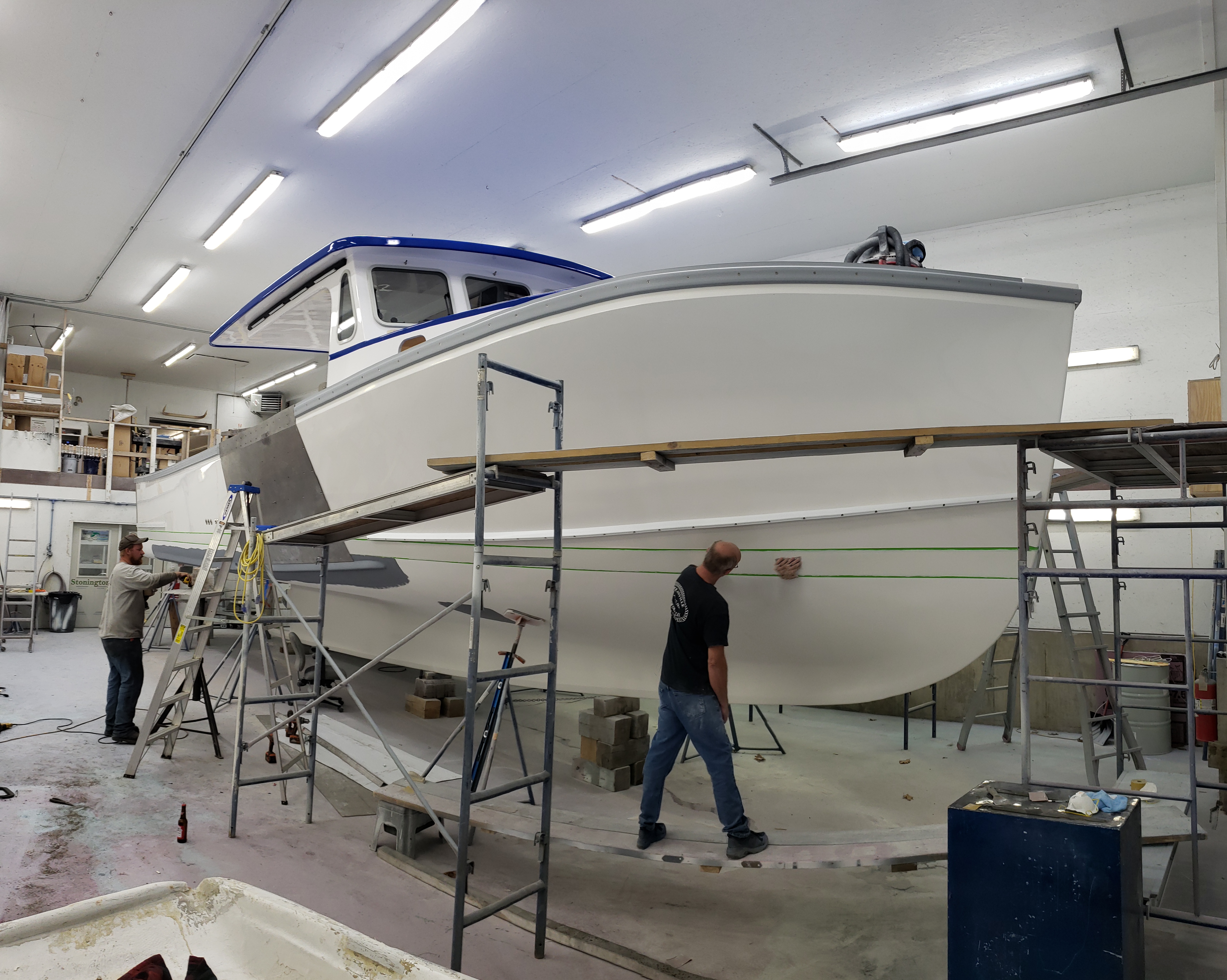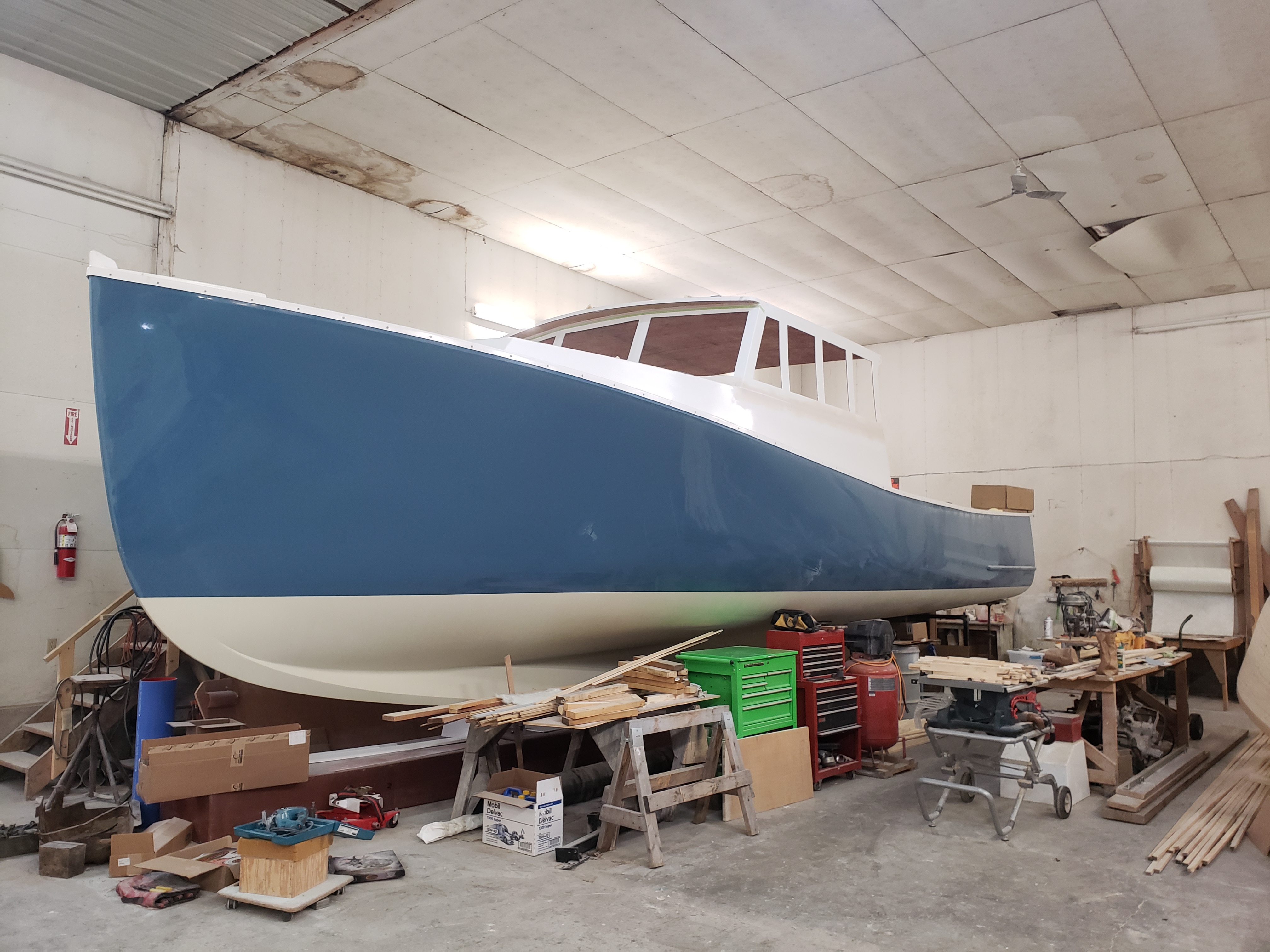Holland’s Boat Shop in Belfast, Maine, has a fairly long list of boats to build — 13 to be exact. The list includes several skiffs, two 20-footers and four in the 30-foot range. But “there’s not a lobster boat in the bunch,” says the boatshop’s Glenn Holland. It’s all pleasure boats, except for one that’s in the corner of the shop. The lines of the bright blue and white hull stand out, from the easy flowing sheerline that rises slightly at the stern, to the gently curving bow with a sharp entrance, to the rounded bilges that flatten out back aft.
It’s a 32-foot tuna boat for a Cutler, Maine, fisherman that will be outfitted with a 650-hp Cat, which should top her out in the mid-30-mph range. It has all fiberglass framing and Coosa Board decking.
“The only place there’s plywood is down below in the bunks,” says Holland. She’ll probably have a standard wheelhouse. Holland’s Boat Shop is installing the Cat, matched up to a ZF gear with 1.5:1 reduction. But the boat’s owner will finish building the boat.
Another boat that’s on Holland’s mind a lot isn’t in to be worked on, though it was scheduled to be in the shop this winter. The Red Baron is a Holland 32 that was a crowd-pleasing force to be reckoned with in Maine’s lobster boat racing circuit in the 1980s and 1990s. Holland says he was planning on getting the Red Baron ready for racing. But “every time I figure I’m going to put the damn boat back together, life gets in the way.” That “life” is the covid-19 pandemic, and now “there’s no way that will happen.”
The last time the Red Baron raced was the summer of 2000. The engine that was in her back then, a big block Ford with a blower that put out about 1,000 hp and got the Red Baron up to 57.8 mph, still sits on the shop floor.
If the Red Baron does return to racing, she will be a lot lighter. Holland has stripped her down to the bare hull, even taking the stringers and girders out. “I’ll put everything back together just as light as I dare. Next time she ought to be well over 60 mph.”
At Oceanville Boatworks in Stonington, Maine, the Father’s Son, a 44 Calvin, was due to be launched the first of December for Brandon Bunker, a Southwest Harbor lobsterman. This is a step up in size for Bunker, who “is in a smaller one now,” said the boatyard’s Dale Haley.
The Father’s Son has a split wheelhouse and an 800-hp Scania bolted to the engine beds. For setting traps there’s an open transom with a manual tailgate. Belowdeck are three lobster tanks and a rope locker for the pot hauler.

A 54-foot Mussel Ridge from Hutchinson Composites that was cut down to 50 feet (49' 11" on the waterline) will be finished off as a lobster boat for a Waldoboro fisherman, after the Father’s Son is launched and Billings Diesel, also in Stonington, installs a 16-cylinder Volvo. The deck will be extended 3 to 4 feet past the transom. A 50-footer makes a lot more sense, says Haley, because over 50 feet “is a lot more money. It requires a naval architect, and the Coast Guard has to get involved.”
The last lobster boat to be launched prior to the Father’s Son was the Shelby Jayda, a Wayne Beal 50 that went to Jake Thompson on Vinalhaven Island at the end of 2019. It’s all composite construction with fiberglass I-beams and deck beams, Coosa Board panels and Divinycell foam. “Everything we’ve done is all composite,” says Haley. “You ain’t got to worry about it. The value of the boat stays up because there’s no wood in it. The boats don’t soak up water and stay about the same weight.”
Two Stonington lobster boats were in for repairs in the spring of 2020. The Sleepless Nights, a 36 Calvin, received a complete Awlgrip coating and had the engine box rebuilt after Billings Diesel pulled the John Deere diesel and installed a new 675-hp Scania.
The second Stonington lobster boat was the Sea Fox, which got a new winterback, and the cabin top and trunkhouse top were ground down and reglassed. “They were so bad, peeling and cracked,” says Haley. Then everything got a coating of Awlgrip. “Anybody in here, we talk them into Awlgripping. Gelcoat, you can’t even clean after two years. This stuff usually stays pretty clean for a few years.”







